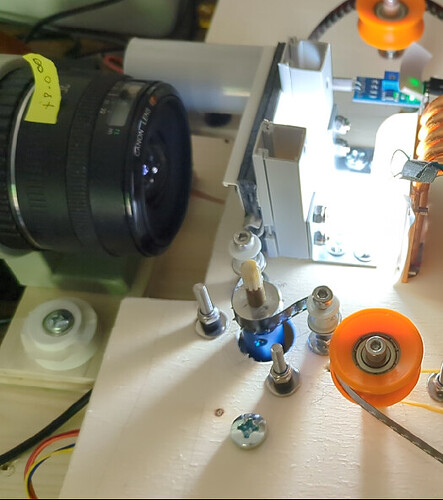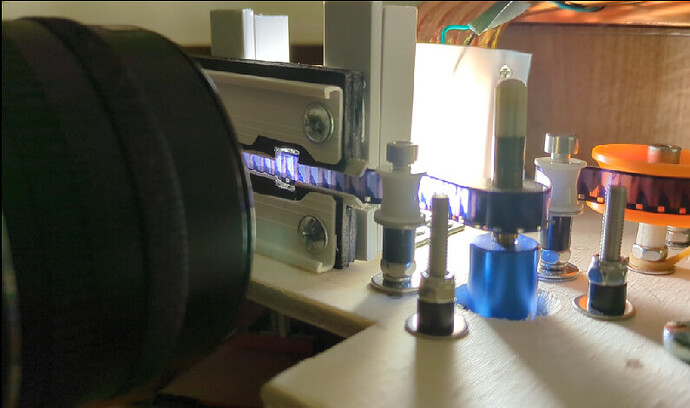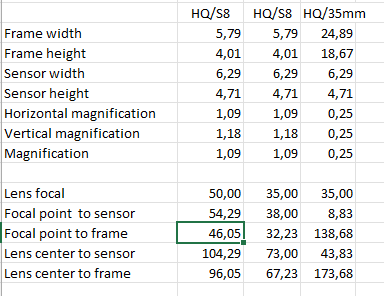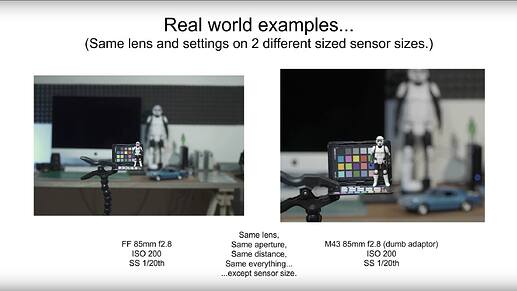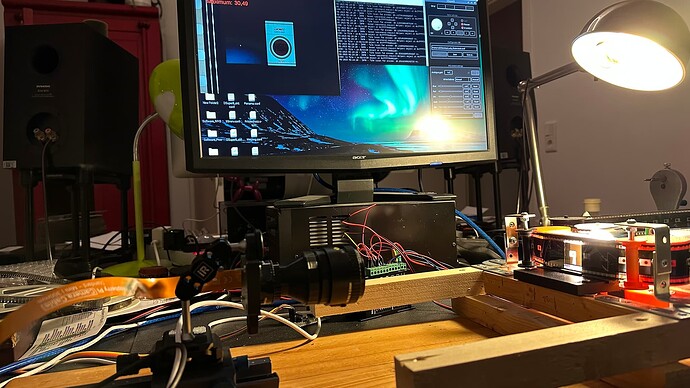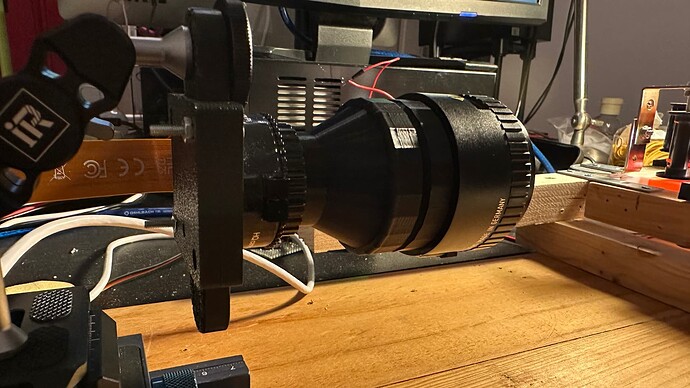I’m developping a small 35mm scanner, using DS8 electronics and software from @Manuel_Angel. Here you can find a small video about the scanner called Lumi 35: https://youtu.be/xypYzaK6ssk?si=WI4-LQZuNFkQ4txw and here you can find the result https://youtu.be/AHLDQx7DdMg . It’s a prototype still under development.
And my first trial to acquire the optical audio from scan https://youtu.be/TJQvOPVhgrY
My latest setup is using the Rodenstock Rodagon 50mm f1:2,8 lens on the Rpi HQ camera. The distance between lens and film is about 350 mm. Is it possbile to find a lens system so it can be put closer to the film? Would putting the Rodenstock lens in reverse be of help here? https://youtu.be/w2RaOlH2nu8
I don’t have the scientific background most of you seem to have, so what I’m writing might be absolutely trivial, but for the first iteration of my 8 mm scanner I used a Canon f2/35mm Lens and was about 3 cm close to the film, as opposed to about 8 cm with the Schneider 50mm.
The lens has a close focusing limit of 25 cm, while the Schneider has 50 or 100cm, I think? So that would be the stat I’d look for. The Canon is great and fairly cheap, and at about f7.1 I didnt see any difference in sharpness compared to the Schneider, but you need a Canon camera to set the aperture, which ist not very convenient.
Bedankt, thank you @verlakasalt. This is for me also unknown ground. Just managed to 3D design and print a 40,5 to 42 mm (male/male) adapter ring so I can start exploring the differences forward and reverse mount. My camera will continue to be the Rpi HQ camera, since I’m a fan of DS8. To be continued.
For a 35mm lens the film/lens value 3cm seems curious to me? In the case of the HQ camera and the S8 film the optical calculation is especially simple, the magnification is approximately 1 and in this case the film/lens and lens/sensor distance are approximately equal to twice the focal length of the lens. The optical calculations are not very complicated and for an exact calculation I gave in a previous post an Excel calculation.
https://forums.kinograph.cc/t/c-mount-rpi-hq-camera-to-m39-componon-s-f2-8-extension-tube-for-3d-printing/2679/6?u=dgalland
I used about 6-8 cm of extension tubes and I’m positive I had to get this close to the frame (it’s the reason why there’s a cutout in front of my film gate…).
Actually, I couldn’t follow the calculations in the Excel sheet (not because I know better, I just didn’t arrive at a result that made sense).
How do you know the lenses focal points? When I look at 35mm lenses, they all have a different close focusing limit. A 300mm lens can be a regular telephoto lens or a 1:1 macro. The latter I can use as-is, the former needs a couple of extensions to arrive at the same magnification. But there might be something essential that I’ve misunderstood…?
The closest point of focus with the Canon is at 25 cm. Magnification is 1.4 when used without extension tubes. But that’s for a 35 mm sensor, and the HQ camera only sees a fraction of it.
![]()
Thank you @dgalland, will study this very interesting article and try to adapt the excel to 35mm.
Found two photos.
Admittedly it looks a bit more like 4 cm, but it’s still much closer than the Schneider 50mm, which is about 8-9 cm away. ![]()
Unfortunately, I do not have a great knowledge of optics. However, by analogy with lenses used in general photography, short focal length lenses produce smaller images of subjects than longer focal length lenses.
For example, when photographing a certain subject, a 35mm lens will produce a smaller image than a 50mm lens at the same capture distance.
To obtain a similar size image with the shorter focal length lens, we must logically get closer to the subject, which is precisely what we are looking for in this case, reducing the camera-subject distance in a scanner suitable for the 35mm format.
I would not be able to give mathematical calculations that allow a first theoretical approximation.
Simulators, in principle, give good approximations for simple lenses, but it is much more complicated in the case of complex photographic lenses. Let us bear in mind that we intend to focus on a subject at a very short distance, the image will be generated at a distance much greater than the focal length of the lens, the use of some extension device is absolutely mandatory.
On the other hand, the trick of reversing lenses is often used in macrophotography to increase the size of images of normally very small subjects. For example, photographing an insect of a few mm in size on a full-frame camera (24x36 mm). The problem with the 35 mm scanner is the opposite, we must reduce the 35 mm frame image to fit on the HQ camera sensor (6.287x4.712 mm).
What I’m missing in @dgalland’s fornula is a representation of the lens-specific closest point of focus (still not sure about the correct English term for “Naheinstellgrenze”…). Because that would surely modify the distances between subject and sensor. But, again, I might’ve misunderstood something :).
My formulas were a bit incomplete, to obtain the frame/lens and sensor/lens distances you have to add the focal length.
These distances are relative to the theoretical center of the lens and not its front face. For example for the Componon this center is located 8mm in front of the rear ring. Note also that these calculations strictly apply only in the case of a single lens.
Regarding the minimum focus distance it’s a bit complicated, here’s what I understand and I hope I’m not saying too much nonsense !
To focus on a close object, a first technique is that of the extension tube.
The closer the object, the longer the tube will be as well as the magnification
This is the direct application of the formulas above and it works perfectly for a lens like the Componon without a focusing ring.
The CANON has a focal length of 35mm and a Minimum Focus Distance MFD of 230mm
Notes:
The focal length is measured for the image of an object at infinity
The MFD is measured from the image plane, the sensor
The MFD is therefore not an intrinsic characteristic of the lens but a characteristic of the lens in combination with the body
To focus as we do not move the lens and its front face, it is a group of lenses that moves inside the lens
This changes the position of the optical center of the lens and probably also the focal length
But this is only possible within a certain limit hence the notion of Minimum focus distance
To scan 35mm film with an HQ camera the magnification would be 0.25 you have to reduce the image by a quarter
So you need a large extension tube but between the film and the lens !!
This should be possible with a 35mm lens and a tube of about 180cm
On the other hand, I am not sure that such a wide angle lens will not cause some distortion of the image??
See some interesting examples with a 35mm photo film scanner
But with larger sensors than the HQ
The HQ sensor seems really small to scan 35mm
Thanks @dgalland. I’m still investigating but already am getting “closer” to what I want, even with the Rodagon 50mm f1:28 lens. Currently a sharp image of a full frame 35mm film (including part of the sprockets) at a distance of 25cm between front of the lens and the film frame. Minimum of extension tube used and try now to optimize it using a 3D printed adapter/tube between the Rpi HQ (C/CS mount) and the Rodagon lens (M39 x 26Gg (0.98 mm pitch)). Need to develop some Fusion360 knowledge on how to create best fitting for the Rodagon thread. To be continued.
This is exactly what the calculation gives
Frame/LensCenter 248mm and Sensor/LensCenter 62mm
Why get complicated with 3d printing, it’s very easy to find all the adapters and tubes at a reasonable price ?
Thanks @dgalland. Well I like to challenge myself, learn and become flexible. During my experiments I’ve learned that the length of the adapter ring is very important. Sometimes it is really depending on mm’s. My current 3D printer allows very precise printing and it is fun to create usefull objects.
This particular Canon is pretty decent ![]()
In our particular use case? We still see a distortion in the corners that we don’t see with the EF 50mm
Wouldn’t the “crop-factor” of the Pi HQ sensor help with reducing the distortions?
If the sensor doesn’t “see” the edges of the lens, it doesn’t matter if they’re distorted or less sharp?
… Unless things behave differently with extension tubes…?
At least, with a subject the size of 8 mm film I couldn’t see a difference between the Schneider (50mm/2.8 Componon-S) and the mentioned Canon lens, but I also only compared individual frames, not proper test images, so all of this is highly subjective. ![]()
It has been a while.. a small update: I’ve been able to develop threads in Fusion360, and use Tinkercad to import these as STL and develop adapters. Latest version uses C-mount to M39 allowing only 23 cm between film and front of lens. Next step is trying to develop a camera vertical slider with 3D printed parts.
I also made a small video about developping the thread: https://youtu.be/xkyLXJjKQpg?si=49Czuf_qd7i9lt8C
